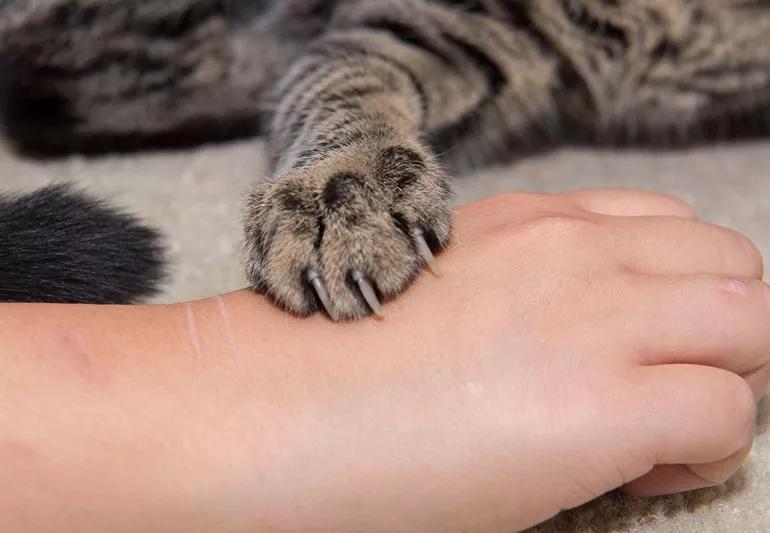Clean the wound immediately with mild soap and water. Contact a veterinarian for further advice and possible treatment.
Cats can often get into fights, leading to scratches or bites. These wounds can become infected if not treated promptly. Cleaning the wound right away helps prevent infections and complications. A veterinarian can provide proper care and prescribe necessary medications.
Keeping your cat’s vaccinations up to date is crucial for preventing diseases. Monitor the wound for signs of infection like redness, swelling, or discharge. Timely intervention ensures your cat stays healthy and recovers quickly. Always seek professional advice for the best care.

Credit: health.clevelandclinic.org
Immediate Action If Cat Is Scrathed Me Or Bitten
If your cat gets scratched or bitten, quick action is crucial. Timely care can prevent infections and further complications. Follow these steps to ensure your cat’s safety and health.
Assess The Injury
First, examine the wound. Look for deep cuts or puncture marks. Check if the wound is bleeding heavily. Note any swelling or redness around the injury. A table can help you track these observations:
| Observation | Details |
|---|---|
| Depth of Cut | Deep / Shallow |
| Bleeding | Heavy / Light |
| Swelling | Present / Absent |
| Redness | Present / Absent |
Calm Your Cat
Keep your cat calm to prevent further stress. Speak in a soft and soothing voice. Avoid sudden movements that might scare your cat. Gently pet your cat if it helps to relax them.
- Use a calm tone
- Minimize noise
- Offer a favorite toy or treat
If your cat is too agitated, it might be safer to wrap them in a towel. This can prevent them from scratching or biting you while you tend to the wound.
Cleaning The Wound
When your cat gets scratched or bitten, cleaning the wound is crucial. Proper wound care helps prevent infection and promotes healing. Follow these steps to ensure your cat’s wound is clean and safe.
Gather Supplies
First, gather all the necessary supplies. You will need:
- Clean towels or gauze pads
- Antiseptic solution or mild soap
- Warm water
- Hydrogen peroxide (optional)
- Pet-safe antibiotic ointment
- Bandages (if needed)
- Gloves
| Supply | Purpose |
|---|---|
| Clean towels or gauze pads | For drying and cleaning the wound |
| Antiseptic solution or mild soap | To disinfect the wound |
| Warm water | For rinsing the wound |
| Hydrogen peroxide | For deep cleaning (use sparingly) |
| Pet-safe antibiotic ointment | To prevent infection |
| Bandages | For covering the wound |
| Gloves | To keep your hands clean |
Proper Cleaning Techniques
Wear gloves to protect your hands. Start by rinsing the wound with warm water. Use a clean towel or gauze pad to gently clean the area.
Apply an antiseptic solution or mild soap. Avoid harsh chemicals. Rinse the area thoroughly with warm water. Pat dry with a clean towel.
If the wound is deep, you can use hydrogen peroxide. Apply it sparingly to avoid tissue damage. Rinse again with warm water and dry the area.
Apply a thin layer of pet-safe antibiotic ointment. This helps prevent infection. If needed, cover the wound with a bandage. Ensure the bandage is not too tight.
Monitor the wound daily. Look for signs of infection like redness or swelling. If you notice any issues, contact your veterinarian immediately.
By following these steps, you ensure your cat’s wound is clean and safe. This promotes faster healing and keeps your cat healthy.
When To Seek Vet Help
If your cat gets scratched or bitten, it’s important to know when to seek vet help. Timely intervention can prevent serious health issues. Understanding the signs of infection and emergency situations can save your cat’s life.
Signs Of Infection
Infections can develop quickly. Watch for these signs:
- Redness around the wound
- Swelling at the injury site
- Pus or discharge from the wound
- Your cat seems lethargic
- Your cat has a fever
Infections can spread fast. Always check the wound daily.
Emergency Situations
Some situations need immediate vet care. Look out for these:
- Heavy bleeding that doesn’t stop
- Your cat is having trouble breathing
- The wound is deep or large
- Your cat is limping or can’t walk
- Your cat shows signs of shock (pale gums, rapid heartbeat)
Don’t wait. Get to the vet quickly in these cases.
Administering First Aid
If your cat has been scratched or bitten, it’s important to act quickly. Administering first aid can prevent infections and promote healing. This guide will help you through the process step-by-step.
Applying Antiseptic
First, you need to clean the wound. Use clean water to rinse it gently. This removes dirt and debris.
- Take an antiseptic solution.
- Apply it to the wound using a clean cloth or cotton ball.
- Make sure you cover the entire area.
Antiseptic helps kill bacteria and prevents infection. Be gentle while applying it, as the wound might be painful.
Bandaging The Wound
Once the antiseptic is applied, you need to cover the wound. Bandaging helps keep the wound clean and protected.
- Take a sterile bandage or gauze pad.
- Place it over the wound carefully.
- Wrap it with medical tape to secure it in place.
Make sure the bandage is snug but not too tight. This allows proper blood flow and helps in healing.
| Step | Action |
|---|---|
| 1 | Rinse the wound with clean water |
| 2 | Apply antiseptic solution |
| 3 | Cover with sterile bandage |
| 4 | Secure with medical tape |
Following these steps can help your cat heal faster. Always monitor the wound for signs of infection.
Preventing Further Injury
When a cat is scratched or bitten, it’s crucial to take swift action. Preventing further injury can help your cat recover faster and avoid additional stress. Follow these steps to ensure your cat stays safe and heals properly.
Isolate Aggressor
First, isolate the aggressor to prevent more injuries. Separate the aggressive cat from the injured one. Use a separate room or a pet carrier. This reduces the risk of further fights.
Observe the aggressor for signs of stress or illness. Sometimes, aggression is due to underlying health issues. Consult with a vet if the aggressive behavior continues.
Monitor Interactions
Monitor interactions between your cats closely. Supervise their meetings until you’re sure they’re safe together. Be present and ready to intervene if tension rises.
Use positive reinforcement to encourage calm behavior. Reward both cats with treats when they interact peacefully.
| Steps | Actions |
|---|---|
| 1 | Isolate the aggressive cat. |
| 2 | Monitor their interactions. |
| 3 | Use positive reinforcement. |
By taking these precautions, you help ensure your cat’s safety. This also promotes a peaceful household environment.

Credit: www.youtube.com
Post-injury Care
After your cat has been scratched or bitten, proper post-injury care is crucial. This ensures your furry friend heals quickly and avoids infections. Follow these steps to provide the best care.
Follow-up Vet Visits
Regular vet visits are essential for monitoring your cat’s healing process. The vet can check for signs of infection or other complications. Schedule follow-ups as recommended by your veterinarian.
During the visit, the vet might take your cat’s temperature. They will also examine the wound and might clean it again. Frequent check-ups help in catching any issues early.
Administering Medications
Your vet may prescribe medications for your cat. Administering these medicines correctly is vital for recovery.
Follow the vet’s instructions on dosage and timing. Use a pill pocket or mix the medicine with food if needed. Be patient and gentle while giving medicines to your cat.
Here’s a simple table to help you keep track:
| Medication | Dosage | Timing |
|---|---|---|
| Antibiotic | 1 pill | Twice daily |
| Pain Relief | 0.5 ml | Once daily |
Consistency is key. Make sure your cat completes the full course of medication.
Understanding Feline Behavior
Understanding why a cat scratches or bites is crucial. Cats often show aggression for various reasons. Knowing these reasons helps in resolving conflicts. This guide explores feline behavior and offers solutions.
Reasons For Aggression
Cats may show aggression due to several factors:
- Fear: Cats may scratch or bite when they feel threatened.
- Territorial Behavior: Cats often defend their territory from other animals or people.
- Overstimulation: Too much petting can lead to sudden aggression.
- Pain or Illness: An injured or sick cat may act out aggressively.
- Maternal Instincts: Mother cats protect their kittens fiercely.
Behavioral Solutions
Addressing feline aggression involves understanding and patience. Here are some solutions:
- Provide Safe Spaces: Ensure your cat has places to retreat when scared.
- Respect Boundaries: Stop petting if your cat shows signs of overstimulation.
- Regular Health Checks: Visit the vet to rule out pain or illness.
- Use Positive Reinforcement: Reward calm behavior with treats and affection.
- Gradual Socialization: Introduce new pets or people slowly.
Understanding your cat’s behavior is key. These steps help create a peaceful environment.

Credit: www.reddit.com
Preventative Measures
Preventative measures can keep your cat safe from scratches and bites. These measures protect your furry friend and ensure their well-being.
Vaccinations
Vaccinations are essential for your cat’s health. Ensure your cat receives all core vaccines. Core vaccines protect against common and severe diseases.
Here is a table of common vaccinations:
| Vaccine | Purpose |
|---|---|
| FVRCP | Prevents feline viral rhinotracheitis, calicivirus, and panleukopenia. |
| Rabies | Protects against the rabies virus. |
| FeLV | Prevents feline leukemia virus. |
Safe Play Techniques
Safe play can reduce the risk of scratches and bites. Follow these tips:
- Use cat toys, not hands, for play.
- Avoid rough play with your cat.
- Provide scratching posts to satisfy clawing instincts.
- Supervise play between cats and children.
Keeping your cat’s nails trimmed can also help. Regularly check their nails and trim when needed.
Frequently Asked Questions
What To Do When A Cat Scratches And Bites You?
Clean the wound with soap and water. Apply an antibiotic ointment. Cover it with a clean bandage. Seek medical attention if it worsens. Monitor for signs of infection.
How Do You Treat A Scratched Wound On A Cat?
Clean the wound with mild soap and water. Apply an antiseptic solution. Keep the cat indoors. Consult a vet if severe.
Do I Need To Go To The Doctor If My Cat Scratches Me?
Yes, you should see a doctor if your cat scratches you. Cat scratches can cause infections.
Should I Be Worried If I Got Scratched By A Cat?
Cat scratches can cause infections. Clean the wound with soap and water. Watch for redness or swelling. Seek medical advice if symptoms worsen.
Conclusion
Ensuring your cat’s safety after a scratch or bite is crucial. Always clean the wound immediately and monitor for infection signs. Contact your vet for guidance and possible vaccinations. Remember, prompt attention can prevent complications. Keeping your cat safe and healthy is essential for their well-being and happiness.
